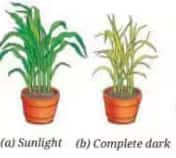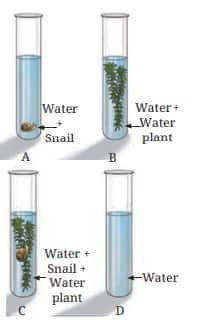NCERT Solutions for Class 7 Science Chapter 10 - Life Processes in Plants
The NCERT Solutions for Class 7 Science Chapter 10 Life Processes in Plants explore how plants perform basic life activities. It includes processes like food production, the transportation of water and nutrients, and respiration. Leaves are referred to as the "food factories" of plants, where food production takes place through the process of photosynthesis. The NCERT Solutions will help students in preparing well for exams as they provide well-written answers.
This Story also Contains
- Download Life Processes in Plants NCERT Solutions PDF
- Access the Class 7 Science Chapter 10 Life Processes in Plants Solutions
- Approach to Solve Life Processes in Plants Class 7 Question Answer
- Important Topics from Class 7 Science NCERT Chapter 10
- Important Question from Class 7 Science NCERT Chapter 10
- What Will You Learn From Life Processes in Plants NCERT Solutions
- NCERT Solutions for Class 7 Science Chapter-Wise

Life Processes in Plants class 7 question answer explains how minerals and water are absorbed by the roots and transported. It also describes how the food made in the leaves is carried to other parts of the plant. How plants produce their food through photosynthesis is also covered. The solutions make it easy for students to learn and remember each concept clearly. Students can easily download the Life Processes in Plants Class 7 PDF for quick revision.
Download Life Processes in Plants NCERT Solutions PDF
The chapter "Life Processes in Plants" explains how plants make and transport food. Students can easily download the Class 7 Science Chapter 10 Life Processes in Plants question answer PDF and use it anytime, even without the internet. It helps them complete their homework and revise quickly before exams. The simple and easy format of the NCERT Solutions for Class 7 Science makes learning clearer.
Access the Class 7 Science Chapter 10 Life Processes in Plants Solutions
The solved exercise questions of the chapter Life Processes in Plants are given below. Continuous practice of Class 7 Science Chapter 10 Life Processes in Plants solutions improves understanding of plants.
Question 1: Complete the following table
S.No. | Feature | Photosynthesis | Respiration |
1. | Raw materials | ||
2. | Products | ||
3. | Word equation | ||
4. | Importance |
Answer:
The completed table is given below:
S.No. | Feature | Photosynthesis | Respiration |
1. | Raw materials | Carbon dioxide, water, and sunlight | Glucose, oxygen |
2. | Products | Glucose, oxygen | Carbon dioxide, water, energy (ATP) |
3. | Word equation | Carbon dioxide + Water → Glucose + Oxygen (in the presence of sunlight) | Glucose + Oxygen → Carbon dioxide + Water + Energy |
4. | Importance | Produces food and oxygen, the foundation of the food chain | Provides energy for the growth and development of all living beings |
Question 2: Imagine a situation where all the organisms that carry out photosynthesis on the Earth have disappeared. What would be the impact of this on living organisms?
Answer: If photosynthesising organisms disappear, there will be no food and oxygen for animals and humans. Plants make food and oxygen through photosynthesis, which supports all life on Earth. Without it, animals and humans would starve and have no air to breathe. The balance of oxygen and carbon dioxide in nature would break, leading to the extinction of almost all living organisms.
Question 3: A potato slice shows the presence of starch with iodine solution. Where does the starch in potatoes come from? Where is the food synthesised in the plant, and how does it reach the potato?
Answer: Starch in potatoes comes from the food prepared in the leaves. Leaves make glucose by photosynthesis, which is carried through phloem tubes to different parts of the plant. This food reaches the underground stem, the potato, where it is stored in the form of starch. The iodine test turns blue-black because of the presence of this starch inside the potato cells.
Question 4: Does the broad and flat structure of leaves make plants more efficient for photosynthesis? Justify your answer.
Answer: Yes, broad and flat leaves help plants capture more sunlight. A bigger surface area means the leaf can absorb more sunlight and carbon dioxide, both of which are needed for photosynthesis. More light and air allow the plant to make more food quickly. This helps the plant grow better and stay healthy. So, such a structure makes the process of photosynthesis more efficient.
Question 5: X is broken down using Y to release carbon dioxide, Z, and energy.
X + Y Carbon dioxide + Z + Energy
X, Y, and Z are three different components of the process. What do X, Y, and Z stand for?
Answer: In the equation:
X = Glucose, Y = Oxygen, Z = Water
The process shown is respiration. During respiration, glucose is broken down with the help of oxygen to release carbon dioxide, water, and energy. This energy is used by the plant for growth and other activities. This shows how plants get energy from the food they make through photosynthesis.
Question 6: Krishna set up an experiment with two potted plants of the same size and placed one of them in sunlight and the other in a dark room, as shown in the Figure.
Answer the following questions —
(i) What idea might she be testing through this experiment?
(ii) What are the visible differences in plants in both conditions?
(iii) According to you, leaves of which plants confirm the iodine test for the presence of starch?

Answer:
(i) Krishna is testing whether sunlight is needed for photosynthesis.
(ii) The plant in sunlight will look green and healthy, while the plant in the dark will look weak and pale.
(iii) The leaves of the plant kept in sunlight will turn blue-black with iodine, showing that starch is made. The dark-room plant will not show starch.
Question 7: Vani believes that ‘carbon dioxide is essential for photosynthesis’. She puts an experimental setup, as shown in the Figure, to collect evidence to support or reject her idea.
Answer the following questions —
(i) In which plant(s) in the above set-up(s) will starch be formed?
(ii) In which plant(s) in the above set-up(s) will starch not be formed?
(iii) In which plant(s) in the above set-up(s) will oxygen be generated?
(iv) In which plant(s) in the above set-up(s) will oxygen not be generated?

Answer:
(i) Starch will be formed in the plant kept in sunlight with carbon dioxide.
(ii) It will not be formed in plants without sunlight or without carbon dioxide.
(iii) Oxygen will be produced in the plant exposed to both sunlight and carbon dioxide.
(iv) Oxygen will not be made in plants without light or carbon dioxide. This proves carbon dioxide is needed for photosynthesis.
Question 8: Ananya took four test tubes and filled three-fourths of each test tube with water. She labelled them A, B, C, and D. In test tube A, she kept a snail; in test tube B, she kept a water plant; in test tube C, she kept both a snail and a plant. In test tube D, she kept only water. Ananya added a carbon dioxide indicator to all the test tubes. She recorded the initial colour of water and observed if there were any colour changes in the test tubes after 2–3 hours. What do you think she wants to find out? How will she know if she is correct?

Answer: Ananya wants to find out how plants and animals change the amount of carbon dioxide in water. If only the snail is present, carbon dioxide increases. If the plant is present, it uses the carbon dioxide. She will check the colour change of the indicator to know if carbon dioxide was added or removed in each test tube. This helps her understand gas exchange.
Question 9: Design an experiment to observe if water transportation in plants is quicker in warm or cold conditions.
Answer: Take two plants of the same size. Place one in a warm place and the other in a cool place. Add coloured water to both pots. After some time, cut the stem and see how far the colour has moved up. The plant in the warm place will show more colour, which means water moves faster in warm conditions. This proves that temperature affects water transport.
Question 10: Photosynthesis and respiration are essential to maintain balance in nature. Discuss.
Answer: Photosynthesis and respiration keep nature in balance. Plants take in carbon dioxide and give out oxygen during photosynthesis. Animals and humans use this oxygen and give out carbon dioxide during respiration. The carbon dioxide is again used by plants. This cycle helps keep the right amount of gases in the air and provides food and energy for all living things to survive.
Approach to Solve Life Processes in Plants Class 7 Question Answer
Understand the topics of life processes in plants thoroughly and apply them to answer questions effectively.
Begin by reading the chapter line by line and write down the important definitions and terms.
Give extra attention to diagrams and processes such as photosynthesis and respiration, which are well-explained in the Class 7 Science Chapter 10 Life Processes in Plants question answer.
Read each question with care to understand which process is being asked in the question.
Use simple language while writing answers as provided in the Class 7 Science Chapter 10 Life Processes in Plants solutions.
Practice previous years' questions and NCERT Solutions for Class 7 to increase confidence in solving questions
Also, check the NCERT Books and the NCERT Syllabus here:
Important Topics from Class 7 Science NCERT Chapter 10
Some of the important topics covered in the chapter are given below. These topics help us understand how plants prepare food, breathe, and move water and nutrients. To gain clarity on these topics, students can use NCERT Solutions for Class 7 Science Chapter 10 Life Processes in Plants.
Photosynthesis
Role of Leaves
Stomata
Transport of Water & Minerals
Transport of Food
Respiration in Plants
Importance of Sunlight
Important Question from Class 7 Science NCERT Chapter 10
The chapter "Life Processes in Plants" explains how plants make their food through photosynthesis. Given below is a question along with the answer. To boost confidence, students can solve more questions using the NCERT Solutions for Class 7 Science Chapter 10 Life Processes in Plants, which follows the latest NCERT guidelines.
Question 1: Which structure in plant leaves is mainly responsible for the exchange of gases during photosynthesis?
a) Xylem
b) Phloem
c) Stomata
d) Cuticle
Answer: The correct answer is option c) Stomata
Explanation:
Stomata are tiny pores found mostly on the underside of leaves. They play a crucial role in the exchange of gases, allowing carbon dioxide to enter the leaf and oxygen to exit during photosynthesis. Stomata also help in transpiration, which is the loss of water vapour from the plant. The opening and closing of stomata are vital for maintaining the plant’s water balance and enabling efficient photosynthesis.
What Will You Learn From Life Processes in Plants NCERT Solutions
This chapter explains how plants carry out different processes like making food, exchanging gases, and transporting water. Some of the main things that students learn are given below:
Students will understand how plants prepare their own food through the process of photosynthesis.
The role of roots, stems, and leaves in transport is explained in the Life Processes in Plants NCERT Solutions.
They will also get to know how plants exchange gases and take in carbon dioxide to make food.
The importance of water absorption and movement in plants is discussed in the Life Processes in Plants class 7 question answer.
Students will also learn how these processes support the overall growth and survival of plants.
NCERT Solutions for Class 7 Science Chapter-Wise
The chapter-wise solutions are given below, by which students can easily study all the chapters and start practicing to score well in the exam.
Frequently Asked Questions (FAQs)
To test for starch, a leaf is first boiled in water, then in alcohol to remove chlorophyll, and finally treated with iodine solution. If the leaf turns blue-black, it indicates the presence of starch, confirming that photosynthesis has occurred in that leaf. The process is well-explained in the NCERT Solution for Class 7 Science Chapter 10 Life Processes in Plants.
Photosynthesis is the process by which green plants prepare their food using sunlight, carbon dioxide, water, and chlorophyll. This process mainly takes place in the leaves and is well-explained in the NCERT Solution for Class 7 Science Chapter 10 Life Processes in Plants.
Plants use two main types of tissues for transport:
Xylem: Transports water and minerals from the roots to the leaves.
Phloem: Transports the food (glucose) prepared in the leaves to other parts of the plant, including roots and fruits.
The primary site for photosynthesis in plants is the leaves, which contain chlorophyll to capture sunlight. Stomata, tiny pores on the leaves, allow the exchange of gases (carbon dioxide in, oxygen out). The roots absorb water and minerals from the soil, which are then transported to the leaves through xylem vessels.
If all organisms capable of photosynthesis disappeared, there would be no production of oxygen and no primary food source for other living organisms. This would disrupt the entire food chain and make life unsustainable on Earth, as plants are the foundation of most ecosystems.
Popular Questions
Courses After 12th
Applications for Admissions are open.
This ebook serves as a valuable study guide for NEET 2025 exam.
NEET Previous 10 Year Questions
Get nowThis e-book offers NEET PYQ and serves as an indispensable NEET study material.
JEE Main Important Physics formulas
Get nowAs per latest syllabus. Physics formulas, equations, & laws of class 11 & 12th chapters
JEE Main Important Chemistry formulas
Get nowAs per latest syllabus. Chemistry formulas, equations, & laws of class 11 & 12th chapters
JEE Main high scoring chapters and topics
Get nowAs per latest 2024 syllabus. Study 40% syllabus and score upto 100% marks in JEE
JEE Main Important Mathematics Formulas
Get nowAs per latest syllabus. Maths formulas, equations, & theorems of class 11 & 12th chapters
